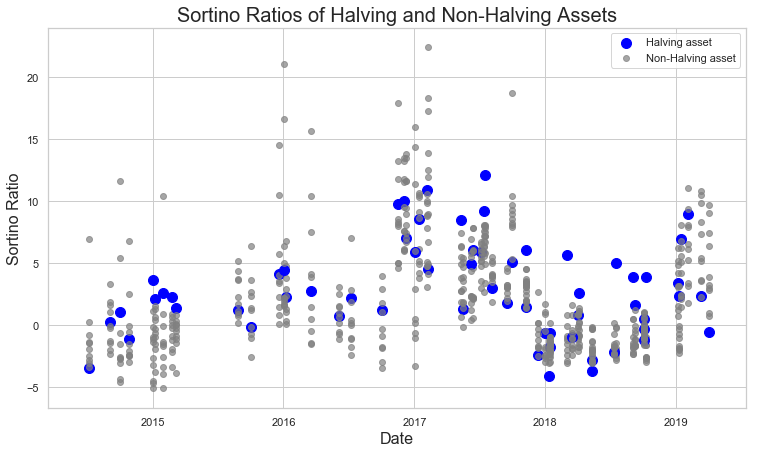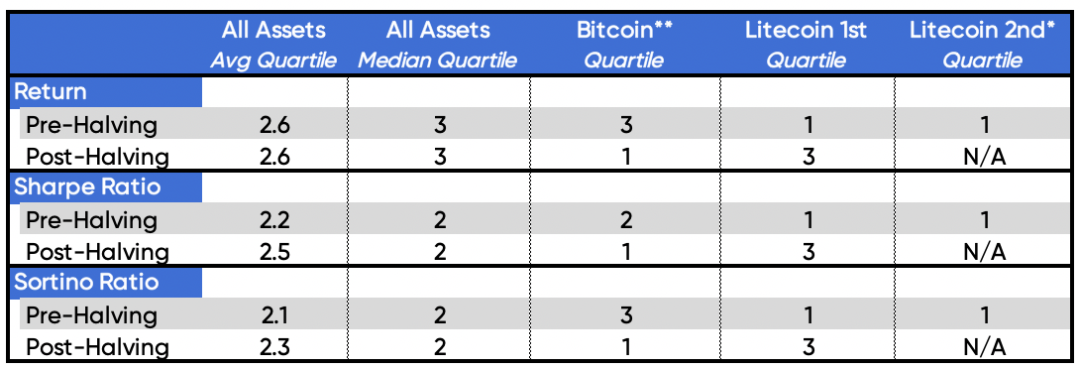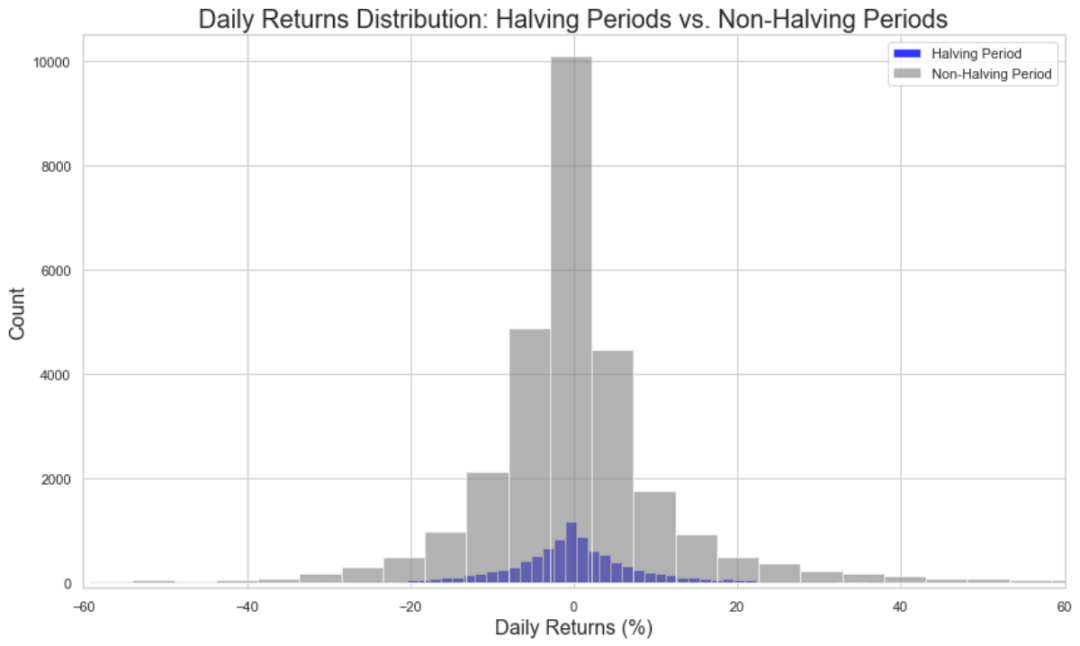We analyzed 32 halvings of 24 cryptocurrencies, telling you how bitcoin halving the price
In the world of cryptocurrencies, we always contact the causal relationship between events or use this causal thinking to explain phenomena. In particular, the halving of the price trend of Bitcoin seems to have become a key signal leading to the rise in bitcoin prices.
This article cites research by Nico Cordeiro and Ava Masucci from Seattle-based startup Strix Leviathan, analyzes 32 halvings of 24 cryptocurrencies, and compares these with overall market benchmarks, challenging the cryptocurrency price Faith – "half". From the conclusion of the study, the divergence and seemingly random results before and after halving indicate that the underlying factor driving price is not a change in supply and demand dynamics, but an event in which fundamentals have changed during this period.
The following is a summary of the report:
A specific question we decided to explore is whether, at a given point in time, statistical analysis of whether the halving event of cryptocurrency would result in a different rate of return (return) curve, the performance of the halving cycle is really better than the overall market. Is the performance better?
- Vitalik: How to distinguish between side chains, Plasma and shards?
- Bitcoin ETF is far away? SEC again postpones decision on three applications
- Securities Times: Digital currency is ready to go, are you ready?
Basic conclusion:
1. According to the statistical regression, in the months before and after the miner's reward was halved, the performance of the cryptocurrency that experienced the halving event was not better than the market.
2. After regression analysis, the income distribution of a crypto asset before and after halving is the same as the distribution of income at other times, and it is highly significant. There is no evidence that the dynamic change of supply and demand leads to abnormal pricing behavior.
3. LTC had better performance than the market in the first few months of halving, but after the first halving, its performance fell to the bottom of 25%.
4. The performance of BTC is completely opposite to that of LTC. Before halving, it has a poor performance relative to the overall market. After halving, it has better performance than the market.
Every financial market needs a set (or sets) of rhetoric to try to explain complex and opaque market behavior, but there is not much historical data that cryptocurrency investors can refer to. This has led to a variety of unconfirmed belief systems that, despite lack of supporting evidence, are generally considered to be properly acceptable. One of the rhetoric is about the halving of Bitcoin, which can be summarized as follows:
The effect of halving bitcoin rewards is that miners will not immediately sell the excavated coins, which in turn will cause an imbalance between supply and demand, which in turn will drive up prices.
Perhaps at this time, in the second quarter of 2019, comments surrounding the "half-half" argument grew exponentially. If you are concerned about traditional media and social media discussions about the upcoming Bitcoin and Litecoin blockchain miners' reward reductions, then you will feel that this is an established fact, all you need to do is hold the HODL to Get excess returns. Although this argument is certainly feasible as a logical theory, it is equally possible that we are faced with an illusion of validity, and the previous bull market is only the result of rising speculative levels in the asset class.
Limited sample size and historical data make it particularly difficult to validate any set of rhetoric in this area. Therefore, in order to test the widely accepted narrative of demand and supply theory, we collected 32 halving data for 24 cryptographic assets (the full list is listed at the end of the article) and cross-market comparisons of the additional 320 markets. Then we will compare and analyze: 1, 3, 6 months before halving; 1, 3, 6 months and non-half after halving:
1. Horizontally analyze the performance of cryptocurrencies with miners' rewards halved and cryptocurrencies without miners' rewards in the same period, and draw their respective quartile matrix.
2. Focus on the price performance of a crypto asset itself during the time period of halving and non-halving.
Before discussing the results, there are actually two implicit assumptions as a premise:
A halving results in a decrease in miners’ returns, and an immediate change in supply relative to demand, which will soon be reflected in the price of an encrypted asset.
In general, cryptocurrency that has been halved will outperform other currencies in the market after halving, as one group of assets has halved, reducing the selling pressure from mining, while the other group No.
 The comparison of asset halving and market Sharpe ratio at the same time. Source: Strix Leviathan Research
The comparison of asset halving and market Sharpe ratio at the same time. Source: Strix Leviathan Research

The ratio of assets halved to the Sortino ratio between markets in the same time frame. Source: Strix Leviathan Research
After completing the analysis, we found that the halving event had a limited impact on the price action. Looking at the total rate of return, the Sharpe ratio, and the Sortino ratio, it can be seen that assets that have been halved, whether before or after halving, are no better than the rest of the market. Among the two most famous cryptocurrencies, Bitcoin (BTC) and Litecoin (LTC), the term “half” is the most, but we can see the opposite.
LTC's performance in the first half of the year has already outperformed the market twice, but in the six months after halving, the market performance has fallen to the last 25% of the total sample data. On the other hand, BTC's performance before the halving was behind the market, but after the last halving, its market performance was ranked in the top 25% of the total sample data. This difference, and the seemingly random results before and after the price halved, suggests that the fundamental factor driving price increases is not the dynamics of supply and demand.

Source: Strix Leviathan Research
*LTC halved for the second time at 8/5/19
** Due to the lack of comparable and reliable data, the first BTC halving is not included
Furthermore, by regressing the different time periods of each asset itself, it can be further proved that the impact of the halving event on market prices is limited. We find that in the 99% confidence interval, the yield distribution during a halving of an asset is roughly the same as the distribution of yields outside the halved period of the asset. In other words, we have not found any evidence that the halving event will lead to abnormal price movements. In fact, we are experiencing an illusion caused by the environment. Everyone feels that there is an impact, that is, it has an impact.
 The ratio of the yield distribution during the halving of the asset to the distribution of the yield outside the halving period of the asset.
The ratio of the yield distribution during the halving of the asset to the distribution of the yield outside the halving period of the asset.
Source: Strix Leviathan study.
Through the previous statistical analysis, at least from the analysis of the data, there is no direct correlation between the halving event and the large change in the price of Bitcoin. With regard to Bitcoin, Bitcoin may have experienced higher than market performance as cryptocurrency enthusiasts generally believe this. However, when discussing the broader asset class, there is a lack of evidence to support the theory, suggesting that the bull market before BTC may also be the result of other factors. In addition, we recommend not inferring other single markets from the sample size of a single market.
Survive in a noisy world
In short, many people in the cryptocurrency market want to use some causality to explain this random market volatility. Kodero and Masuqi succinctly said: "The world of financial markets is full of thousands of logically tight, After well-thought-out theories, these theories often fail to stand in practice."
Those who invest in bitcoin and other cryptocurrencies need to be wary of this prejudice. "Top-level" cryptocurrency traders can achieve some brilliant results, not because of their technology, but purely for luck. It is speculated that many market fluctuations triggered by major news events may be just random phenomena. Many conspiracy theories, such as Tether's price manipulation theory, affecting more than $150 billion in the bitcoin market through issuance, etc., are forcing a causal relationship to explain certain phenomena. The change in the earnings of Bitcoin before, during and after halving is more likely to be due to the rise in speculative levels rather than the imbalance between supply and demand itself.
People are eager for causality, and cryptocurrency market media also try to force most people to believe in storytelling. In a world full of noise, it is important to be skeptical. However, if you believe Bitcoin (or other cryptocurrency) will continue to rise, perhaps the most sensible strategy is to enter the market in a dollar-cost or value-cost average over a long period of time, ignoring the noise.
Original link: https://cryptoslate.com/research-finds-bitcoin-litecoin-halvings-do-not-impact-price/
The research report cited in the article: https://strixleviathan.com/blog/2019/7/21/the-myth-of-cryptocurrency-halving-events-a-deeper-analysis
Translation: Jessie @ Orange Book
The assets evaluated in this analysis include: BTC, LTC, XVG, FTC, MONA, NMC, FLO, POT, ABY, CURE, NYC, MOON, VTC, EMC2, IOP, MEME, COLX, ONION, DIME, LINDA, UNO, TRC , ANC and SXC.
Editor's Note: The original title is: Statistical study of the effect of halving bitcoin on price
We will continue to update Blocking; if you have any questions or suggestions, please contact us!
Was this article helpful?
93 out of 132 found this helpful
Related articles
- Goldman Sachs: Bitcoin will hit a new high in 2019, and these callbacks should be seen as buying opportunities on dips
- China’s central bank’s digital currency and Libra may not directly confront each other, but they all impact payment institutions.
- Blockchain Weekly | China's central bank digital currency "calls out", the global digital currency "race" opens
- How to hide our privacy with Bitcoin wallet?
- US Securities and Exchange Commission postpones three bitcoin ETF rulings again
- 15 countries joined hands to create a "cryptocurrency monitoring system" to see how regulation changes
- Bitcoin makes the remittance fee as low as dust? International banking giants want to cry in the toilet






